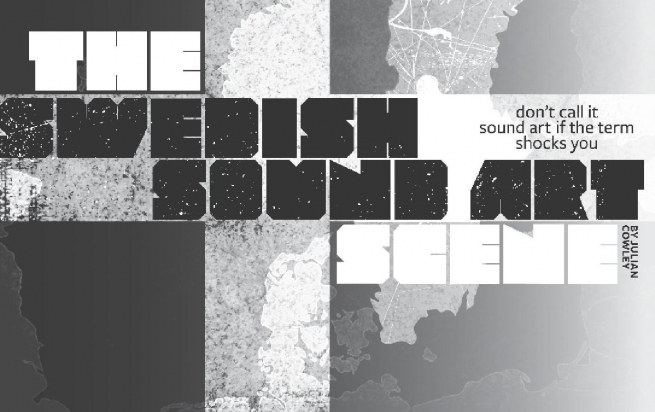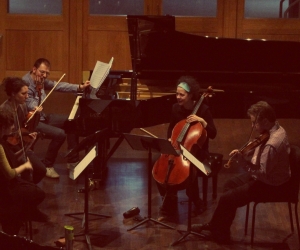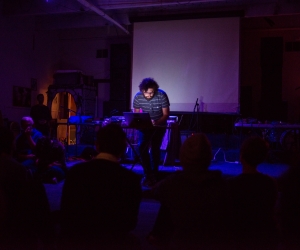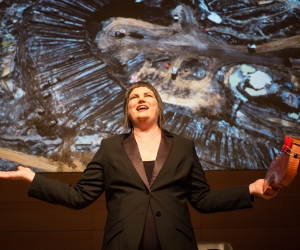
Nadine Byrne
Monochrome images of two young women—evidently sisters—stare out impassively from oval apertures that resemble Victorian cameo brooches. A gauzy ectoplasmic fabric oozes from their mouths while, in an aperture between them, their faces merge in a dreamlike blur to evoke the face of their late mother. The soundtrack to this absorbing five-minute plunge into a haunted psyche mixes grainy droning tones with family recordings from the sisters’ shared childhood, the recurrent clatter of spiritualist table rapping and the indistinct speech of female voices, captured by an investigator of electric voice-phenomena—those faint, otherworldly utterances that sometimes materialize mysteriously on tape recordings made in empty rooms.
This extraordinary sound-and-video installation is Nadine Byrne’s For Kate & Margaret, made with her sister Tanya. The title alludes to Kate and Margaret Fox, mediums whose apparent communications with the spirit world caught the collective imagination of mid-nineteenth-century New York. The Byrne sisters, based in Stockholm, maintain a critical distance from a naive belief in the occult, while making art together as The Ectoplasm Girls, exploring their identity as individuals, sisters, and daughters. In another compellingly enigmatic and moving installation, Minds Look Alike, the face of Nadine, who was born in 1985, morphs into that of her mother at the same age while we hear the mother’s voice, engaged apparently in a therapy session conducted in English.
Both pieces are featured on Sound Art IV: The Swedish Scene, the most recent in a series of promotional DVDs curated by Odd Sneeggen for the Swedish Music Information Centre. The series brings to light the vitality and diversity of current sound-based art in Sweden, a flourishing to rival the 1960s Swedish scene that achieved prominence within the international avant-garde through the radicalism of electronic pioneers such as Öyvind Fahlström and Rune Lindblad, and then the sophisticated developments of text-sound composition. The text-sound approach was given its name by two of its practitioners, Lars-Gunnar Bodin and Bengt Emil Johnson, and, as Bodin subsequently noted, “the term was deliberately neutral in character and could quite easily be stretched to cover virtually everything from sound poetry to Stockhausen’s Gesang der Jünglinge.”
The Sound Art DVD series is comparably free from any desire to place restrictive definition upon the field. Writer Magnus Haglund explicitly states, in his accompanying notes, “what makes contemporary sound art exciting is its indefinable quality, its emancipation from established stylistic patterns and genres.” He continues: “New sound art is every bit as border-crossing as the multi-media environments of the ’60s and uses anything from video to performance art to techno rhythms and linguistic materialism writing strategies.” Eminent sound poet Sten Hanson has acknowledged that earlier advances were made in response to “new working tools and new media: the tape-recorder, the electronic music studio, the L.P. record, the radio.” His generation drew invaluable support from Fylkingen, Stockholm’s long-established society for promotion of experimental music and arts, and from the Swedish Broadcasting Corporation, where in 1968 a state-of-the-art Electronic Music Studio (EMS) was set up.
Crucially, that institutional support didn’t cramp creative idiosyncrasies and maverick vision. But in notes written during the mid-’90s for the CD Constellations, an anthology of Swedish electroacoustic music, Lars-Gunnar Bodin lamented that “there are few people outside the inner circle of originators that show a burning enthusiasm for electroacoustic music.” Today, Magnus Haglund observes, “the increased availability of digital technology, home studio recording and various electronic accessories has resulted in the democratization of creation.” The excitement of the current scene arises not just from its variety of methods and materials and its utilization of new media, but from the disparate backgrounds and life experiences of those involved.
Nadine Byrne, growing up in Stockholm, became aware of the electroacoustic tradition embodied in the history of Fylkingen and EMS. But her approach is different, strongly influenced by the self-sufficient, indie rock DIY attitude, and infused with a love of the cosmic sonorities of bands like Spaceman 3. “I don’t have a very deep knowledge of sound engineering,” she admits. “I use synthesizers, but often quite simple ones. I still use the Casio keyboard my father gave me when I turned ten years old. I use field recordings and I use my voice. Then, I process everything through my computer, running Ableton Live, mostly just using sound effects and the looping function. I don’t program anything. It’s all very basic, and I do exactly the same thing when I record as when I play live.”
Last year, I heard Byrne perform live at an event in memory of that marvellous experimental artist Åke Hodell, staged on the ferry that runs back and forth across Stockholm harbour. Seated introspectively at her laptop, she gradually transformed the insistent mechanical chug of the ferry’s engine into an alluring siren’s song, resonating with her own voice. That stretch of water became, as it had been for Hodell, a resource for the mythopoeic imagination. On a practical level, however, she says that she has never liked using the computer in a live setting. “It’s just that it is so easy—and inexpensive. But I’m planning to change to using more analogue means when playing live. That’s a change I’ve been making in other media as well, starting to film on 16mm instead of video and switching back to photographing on film instead of digitally. There’s a different quality to analogue that makes it more interesting to work with.”
Byrne started playing music as a child, trying out various instruments, writing songs and forming a group with very young friends at a place in Stockholm called The Music Factory. “During my teenage years I tried playing in a band again,” she recalls. “I found playing music was something that came with a set of rules I didn’t like, or didn’t feel good enough to follow. When I realized that art was what I wanted to spend my life doing, I started playing again. That coincided with my mother passing away, and my older sister Tanya and I spent some months living together in a small apartment, almost as solitaries. As a sort of grieving process we started making weird sounds together, and funny little blues songs. We had no technical knowledge, but recorded our sounds using multiple dictaphones and two cassettes. These recordings became the foundation of The Ectoplasm Girls. Soon afterward, we got computers and decided to start making sounds together for real. It’s an artistic project where we can express our fascination with darkness, death and dreams.” A recording of The Ectoplasm Girls is set for imminent release by iDEAL Recordings.
“I’m studying fine art at college in Stockholm,” says Byrne. “It was there that I first realized I could work with sound however I wanted to. That may sound obvious, but it really was a revelation. I discovered it could be a part of my artistic practice just like anything else, and there were no rules to follow. As I became increasingly interested in subjects such as transcendence and ritual I started a project on my own—I call it The Magic State—where visuals and sound operate at the same level, as expressions of the same thoughts. When making a piece, I often envision myself performing, as if in a daydream. I know how I want things to be but, especially performing in a club setting, you have to adapt to what is available. In a more art-oriented setting it is usually easier to make it look good as well as sound good. I like to maximize the effect, I guess really to create an entire world for the viewer-listener to step into . . . and for myself to step into as well.”
Mattias Petersson
On a screen, five vibrating vertical lines register the play of electrical current, like an oscilloscope adapted for contemplation of mantric designs. The accompanying sound is created correspondingly for kinetic circulation through five channels, electricity enveloping listeners within a droning, crackling, squelching swirl. This is Mattias Petersson’s contribution to the Sound Art IV DVD, an excerpt from Ström (current), a forty-five-minute work issued in its entirety in 2002 by the Fylkingen imprint and recently presented live at the Nordic Music Days 2010 festival in Copenhagen. It’s a collaboration with video artist Fredrik Olofsson that testifies to Petersson’s enduring love for electronic sound—indeed, for the sound of electricity. Out of that visceral enthusiasm there emerges a dialogue between abstraction and figuration that eventually settles into hypnotic patterns reminiscent, in a low-key way, of the early minimalism of Steve Reich or Terry Riley.
Petersson, born in 1972, started studying piano at the age of seven and soon became obsessed with the classical keyboard repertoire. Fascinated by musical form and structure, he started composing early, and later studied for two years at Gotland School of Music Composition, which he describes as “a very calm place, isolated on an island, perfect for diving into compositional work and looking for some sort of artistic identity.” The school had a small electroacoustic studio, in which Petersson spent plenty of time investigating. His exploration of electroacoustic and live-electronic sound continued at the Royal College of Music in Stockholm, where he met people involved with Fylkingen and EMS who had a major impact upon his outlook.
He remembers experiencing, some years before this, “a specific moment in the early ’80s when my cousin introduced me to Kraftwerk’s Computer World. I fell in love with the electronic sounds immediately. Some years later I’d saved enough money to buy my very first synth: a Casio CZ-101. This was eventually complemented with a Roland TR-606 drum machine. My father had an old reel-to-reel tape machine that I used to record my strange compositions. These days my most important digital tools include Max/MSP, SuperCollider, Logic, and sometimes ProTools. On the analogue side I have a modular synthesizer customized to allow very precise control via my laptop. I really like the concept of analogue sound sources with digital control, and a modular system can be extended to incorporate other musicians as sound sources. I also use a Monome 256 and a homemade Arduino-based controller to interact with my computer patches. When it comes to controllers, my goal is always to find the perfect balance between a traditional instrument and automated processes that the computer can perform better than humans.”
Ström was actually structured using a magic number triangle, invented by Petersson during the early days of his composition studies. Despite this piece’s dynamic projection in performance Petersson feels that his work generally belongs in the time-based realm of music rather than space-oriented klangkunst. Indeed, his composition There Are No More Four Seasons, also performed at Nordic Music Days, and in August 2010 at The Stone venue in New York, is a climate-change-registering, violin-and-live-electronics deconstruction of Vivaldi’s perennially crowd-pleasing concerti. But although he is making music, Petersson nonetheless finds the term sound art useful. “I strongly believe that the power of art lies in the mind of the beholder. When I’m working on a piece. I almost always think of the performance and what kind of impact it will have. If I tell an audience I make music, a lot of preconceptions immediately kick in and they expect me to do something that they would call music. If I use the term sound art the audience has few preconceptions and knows that it could be almost anything.”
Henrik Rylander
Nadine Byrne and Mattias Petersson have arrived on the Swedish sound-art scene from diametrically opposed angles, in terms of formal musical training; yet both are clearly attuned in their very different ways to John Cage’s epochal dictum, “You don’t have to call it music if the term shocks you.” Gothenberg resident Henrik Rylander, born in 1966, has taken yet another route into that scene, including advanced study in photography during the ’90s. He actually cites Cage’s statement as a major shaping influence on his work. Rylander’s contribution to the second in the series of Sound Art DVDs presents still photographs and texts from his 2007 art book Public Loudspeakers—Information & Disinformation, with soundtrack drawn from the accompanying CD.
The images show loudspeakers in public places—perched in stadiums, arenas, squares, and department stores, and installed on public transport in Stockholm, Gothenberg, and Malmö. One text used in this piece quotes Hitler’s 1938 pronouncement, “Without the loudspeaker we would never have conquered Germany.” Other texts allude to Stalin’s confiscation of private radio receivers, the controlling function of public broadcasts in Maoist China, CCTV (closed-circuit TV) cameras in the UK fitted with loudspeakers to issue spoken warnings to transgressors in the street, and other loudspeakers in Sydney, Australia that broadcast recordings of Barry Manilow to disperse gatherings of punks. The soundtrack to this visual essay on the flow of power through public space was created using audio software to process data from the tagged image files of Rylander’s photographs. An articulated electronic pulse soon dissolves into a messageless oceanic roar of white noise.
In 1984 Rylander became the drummer in a group called Pleasure and Pain, which he describes as influenced by the industrial sound of Einstürzende Neubaten and Throbbing Gristle, “rhythm based, with lots of hammering and scratching on metal, floor-toms, and various kinds of construction workers’ tools.” The following year he formed a higher profile group, Union Carbide Productions, playing psychedelically tinged punk rock. They recorded for Radium 226.05 Records, the adventurous label run by C. M. von Hausswolff, Ulrich Hillebrand and Erik Pauser. “It was at the Radium office—where you could meet artists and musicians like Rune Lindblad, Richard Kern, Leif Elggren, and Zbigniew Karkowski—that my interest in art and, to some extent, in experimental electronic music began,” Rylander recalls. He is a member of Fylkingen and is aware of Stockholm’s radical and distinguished electroacoustic tradition, but acknowledges a clearer sense of indebtedness to Gothenberg’s punk and industrial music scene during the ’80s. He remains musically very active, drumming and using feedback mixer with hypnotic noise-rock outfit The Skull Defekts, and working in the duo SKLS with fellow drone technician Joachim Nordwall.
In 1997, however, Rylander had his first solo exhibition, a fifty-minute recording of a walk around his home city, relayed into a gallery space through hidden speakers. “Later on I started to conceptualize my art towards issues of information and disinformation, power and propaganda, and also ideas about the act of listening in relation to the act of seeing. I constructed a self-generating sound system by using feedback, produced with microphones and speakers, or internal electric feedback with audio mixers. And I started to use the overloaded mixer as a metaphor for overload of information.
“In my live performances, as well as recordings, in recent years I’ve almost solely used feedback mixers as my musical instruments. I like the way the mixer becomes a kind of controlled chance unit, unpredictable or indeterminate, and I hardly ever use overdubs because I want to be able to perform live with similar sound results to those in the studio. Rhythm played an important role on my first records and is still present but not as evident. Recent releases are more about drone and feedback noise, but never static, always in flux.” Rylander’s 2008 CD Power Model X (Motherboard Drone Live) (iDEAL Recordings) presents two dense clouds of sound, weighty and oppressive but internally animated with pulsation, shimmering eddies and slowly shifting intensities. They are actually recordings made at gallery installations in Gothenberg and Chicago. Rylander regards this process of transferral from specific site to portable medium as a transformation of art into music. “I tend to not use the term sound art often,” he explains, “because I think the definition is too wide. But sometimes it is the easiest way to explain what you do.”
Taxonomists and philosophical purists may wince, but that pragmatic and open approach to terminology is being nurtured in Sweden today as a means to encourage and support creative experimentation. And it’s clearly working. The term sound art is being used as a provisional, mobile marker on a variegated terrain of creative activity, rather than as a fixed boundary or controlling centre. That stimulates growth.
Checklist of other young Swedish sound artists
Nadine Byrne, Mattias Petersson, and Henrik Rylander are representative only in their markedly disparate approaches, equally disparate personal backgrounds, and their common desire to reach responsive audiences for their work. Other young artists might have been featured here, such as Daniel Skoglund, Lina Selander, Daniel Rozenhall, Liv Strand, Johannes Heldén, Marja-leena Sillanpää, Johanna Billing, Johanna Rosenqvist, Mathias Josefson, Christine Ödlund, Erik Bünger, Andreas Gavell Mohlin, Anna Linder, or Mira Eklund. The presence of so many women on the scene is a notable change from the 1960s and another significant indicator of the health of the Swedish scene. It’s expansive and inclusive, and the bottom line is, you don’t have to call it sound art if the term shocks you.
Audio: Walk-in-Sound (Excerpt from installation, 1997). Composed by Henrik Rylander. Image designed by: Lucinda Wallace.


